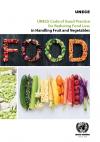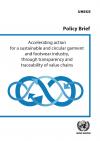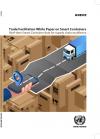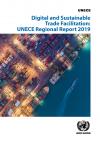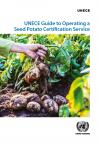Trade Publications
Displaying Results 61 - 80 of 277
- English
Inshell Walnuts Poster
The UNECE standard applies to inshell walnuts* free from outer husks, of varieties (cultivars) grown from Juglans regia L., intended for direct consumption or for food when intended to be mixed with other products for direct consumption without further processing. It does not
- English
A Code of Good Practice which helps maintain quality along the fresh fruit and vegetables supply chains, to prevent and reduce food loss and waste. It sets out measures to be taken at the various stages of the supply chain before the fruit and vegetables reach the consumer, i.e. from harvest to
- English
The garment and footwear industry has one of the biggest environmental footprints and poses great risks for human health and society. At the same time, the complexity and opacity of the value chain makes it difficult to identify where such impacts occur and to devise necessary targeted actions.
- English
Technology is entering into every aspect of the supply chain and providing performant and innovative tools. As many are just starting to talk about the dematerialization of certain documents used in trade and transport, others are investigating how devices can communicate information directly
- English
Trade facilitation is a key factor in national competitiveness and in the economic development of countries. At the same time, the development of a simplified and automated trade environment is a challenging reform programme for any country. It requires strategic vision, leadership, change
- English
It is fair to say that trade facilitation is a key policy priority for most if not all the trading nations. The benefits for implementing trade facilitation provisions such as the ones in the World Trade Organization’s (WTO) Trade Facilitation Agreement are well documented. However, the need
- English
Within the United Nations Economic Commission for Europe (UNECE), the United Nations Centre for Trade Facilitation and Electronic Business (UN/CEFACT) has developed a series of some 30 recommendations and standards that are used worldwide to simplify, standardize and harmonize trade procedures
- English
Since 2010, the UNECE has been undertaking demand-driven national studies of regulatory and procedural barriers to trade, with a view to: helping countries achieve greater regional and global economic integration; informing donors as to where assistance might be required; and, supporting policy
- English
Gender Responsive Standards publication (ECE/TRADE/445) makes the case for mainstreaming gender in the development and implementation of standards. The first chapter places the discussion in the larger perspective of how standards contribute
- English
This Glossary (ECE/TRADE/377/Rev.2) represents an English-Russian-Chinese dictionary of terms that are widely used in trade facilitation. This is the third, revised and completed edition including new terms in trade facilitation and
- English
Public procurement alone represents 15-20% of the global GDP, while procurement commitments under the World Trade Organization’s Agreement on Public Procurement (GPA) have been estimated at around EUR 1.3 trillion. This is enormous purchasing power that can drive investment and innovation
- English
Streamlining border crossing and helping traders to access international markets can provide significant stimulus to national economies and directly supports the implementation of UN Sustainable Development Goal (SDG) 17, specifically on promoting a universal, rules-based, open, non-
- English
This guide (ECE(TRADE/434) has been developed to assist Certifying Authorities (CAs) in the operation of their seed potato certification service and to encourage standardisation in the operation of seed potato certification services between CAs. The guide is also intended to assist countries that
- English
This publication (ECE/TRADE/444) presents the results of an ongoing research on the practical experience of regulatory authorities, governments and local administrations, as well as regional groups of countries, in using standards towards
- English
Since 2010, the ECE has been undertaking demand-driven national studies of regulatory and procedural barriers to trade, with a view to: helping countries achieve greater regional and global economic integration; informing donors as to where assistance might be required; and supporting policy
- English
This Guide (ECE/TRADE/441) is a practical tool to help trainers in the preparation, delivery and follow up to a set of training workshops.
Both this guide and the workshop materials have been prepared by the UNECE Secretariat, with the
- English
This Publication (ECE/TRADE/440) advocates for integrating education about standardization into the curricula of educational establishments. It presents evidence of the relevance of standards for policymakers and business executives as well
- English
As the second most polluting industry, the textile sector is responsible for a large portion of the world’s CO2 emissions and industrial waste, not to mention the exploitation of “indecent” working conditions. At the same time, the industry has a complex value chain, with production facilities
- English
Within the United Nations Economic Commission for Europe (UNECE), the United Nations Centre for Trade Facilitation and Electronic Business (UN/CEFACT) has developed a series of some 30 recommendations and standards that are used worldwide to simplify, standardize and harmonize trade procedures
- English
The Economic Commission for Europe (UNECE) has a long history of offering trade facilitation guidance, especially on the topic of Single Window. Since its emergence in 2004, Recommendation 33 on implementing a Single Window has been widely received as the reference on the subject and is used as

